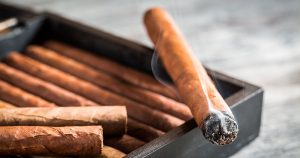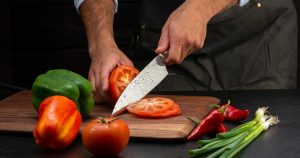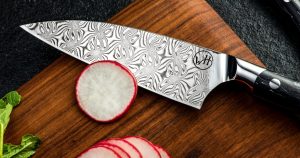From functional and life-sustaining tools to emblems of strength and style, handcrafted knives have become the quintessential instrument for the modern-day warrior. Behind a luxury knife’s razor-sharp utility and flawless aesthetic lies an enduring tradition of hand-engravers, silversmiths, and other highly-skilled artisans keeping the craft alive.
The advent of laser and machine engraving increased access to these sharp cutting devices but dwindled the need for imaginative artistry and decades of experience offered by knife makers. William Henry is on a mission to restore the purity of knives as an art form, as well as delight and inspire with exotic and sustainably-sourced materials that tell a captivating story.
High-quality metal alloys and gemstones are only as good as the craftsman who molds and shapes them into an exemplar of ingenuity and technical prowess. We utilize ancient techniques to harken back to a simpler time and create inventive and daring designs on our handcrafted knife blades and handles. Explore more of the long-established knife-making techniques that we employ at our studios below.
Fine Hand-Engraving
Fine hand-engraving is a time-honored craft that requires multiple years of experience and refinement. Old-world engravers didn’t have the luxury of computer-aided design or our contemporary engineering innovations. Aspiring apprentices had to seek mentorship and spend years honing various engraving techniques. The slow and arduous process of learning the trade was eased with newer tools and processes.
Hand-engravers use a basic technique called “push graving,” in which an engraver uses a hardened and sharpened steel tool called a graver to push through the metal’s surface. Simple, but refined hand engraving requires an adept mastery of motor control and pinpoint precision. Oftentimes, a small and lightweight hammer may be used to create deeper and more vivid details on the surface of a metal.
Gravers are strong and durable implements with sharpened edges at specific angles meant to create various cuts on metal. As a masterful engraver pushes the graver forward, curls of metal spew from the sharpened edge leaving behind a smooth groove. Artisans hold the graver in various angles throughout the cuts to create thick and thin gradations in the line. These gradations come together to paint a bold design.
William Henry carves all of their metals by hand with plain, but effective tools and techniques. Our first-rate silversmiths spend long hours in the studio crafting breathtaking and sleek carvings in hard materials such as sterling silver. On top of these artisan-crafted metals, we add a splash of precious stones and the finest gold available to add a luxurious and timeless touch.
Koftgari
Parkerization of steel is used to protect the surface from corrosion and improve its toughness. We use an ancient Indian technique called “koftgari” to inlay fine gold and silver designs into parkerized steel or iron surfaces. William Henry's koftgari comes from two small villages in India, home of the very few Indian artisans that still master this technique. These heated metals are pounded into a flat surface to create a distinct shape and carve grooves on it.
During the koftgari process, knife-makers must create a precise cross-hatch grid in the steel, which acts as a base for the fine gold or silver. After the cross-hatch grid has been created, fine gold or silver can be burnished into the pattern and be bound by the craftsman’s fine markings. After hammering and polishing the surface, the pattern is imbued as an enduring legacy.
This ancient decorative art technique was originally created by the Mughals in India to emblazon their weaponry. Today, it can mark our most indispensable tools. The term koftgari refers to the beating technique used to flatten the pattern onto the iron or steel. Koftgari techniques differ from region to region and artisan to artisan. Regardless of differences in techniques, knife makers can create stunning motifs displaying years of acquired skill.
Maki-E
At William Henry’s studio, we source all of our materials and techniques from the best artisans in the world. Our commitment to legacy and art led us to the discovery of Maki-e, an ancient Japanese technique used to decorate exquisite surfaces. The tried-and-true technique consists of sprinkling gold or silver powder onto a smooth lacquered surface using a fine brush.
This decorative technique was first used in the Heian Period (794-1185) and flourished thereafter. While this ancient practice was primarily used to decorate household wares, it quickly developed a reputation as a luxury and refined art form for the wealthy. Maki-e artists use a variety of metal powders to create different hues and textures on a smooth surface.
An expert Maki-e artisan must spend years, sometimes decades, learning the skills necessary to mix powders such as silver, copper, gold, platinum, or brass onto a blank canvas to create an idyllic or magical representation of life. After refining the technique, artisans can freely and proudly call themselves an exceptional Make-Shi (artist).
The magic of Maki-e art lies in the Urushi lacquer derived from the sap from the native Japanese Urushi tree. This Southeast Asian sap is often collected by hand from over 600 different Urushi species. Then, the sap is painstakingly processed to create the Maki-e lacquer we all know and love. This adhesive base keeps the entire design in place.
Maki-e’s technique requires craftsmen to use fine brushes to create multiple layers of lacquer, artwork, and inlaid metal flecks. This time-intensive project showcases an unrivaled ingenuity for using various materials in the most precise manner when we apply the technique to our luxury knives. The combination of these techniques produces the mesmerizing and refined William Henry knives available in various styles and designs.
William Henry's artists take decades to perfect their hand engraving, koftgari, and maki-e techniques to craft dazzling and fresh designs over our blades and handles. Every inch of a William Henry knife features unique and handcrafted details that are a testament of our materials’ resilience and our penchant for groundbreaking artistry. Knifemakers are continually developing their unique artistic style to connect the user with the knife and its remarkable origins.









